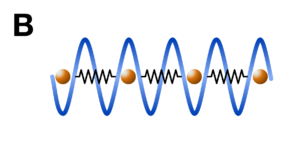Area B: Quantum cooperativity of collective degrees of freedom
Summary of the area
Area B aims at characterizing quantum cooperative dynamics of the collective degrees of freedom in mesoscopic systems. The aim is to push the limits of quantum cooperativity to the mesoscopic scale. The five projects conforming this area utilize different collective excitations across a wide range of different parameters. They include the dynamics of optomechanical collective modes of cold atomic ensembles, the properties of transport in crystals of trapped ions and in the presence of quantum defects, the controlled interaction of light with mechanical or magnetic degrees of freedom in nanostructured and levitated solid state systems.
Projects
- B01 – Collective quantum dynamics of structural- and spin-defects in ion crystals
- B02 – Levitated ferrimagnetic particles in hollow-core photonic crystal fibres
- B03 – Point defects in silicon carbide: Towards a platform for the coupling of light, spin and mechanics
- B04 – Opto-mechanical lasing mechanisms in cold atoms
- B05 – Optomagnomechanical Arrays
Publications
2023
- , , , , :
Magnomechanical backaction corrections due to coupling to higher-order Walker modes and Kerr nonlinearities
In: Physical Review B 107 (2023), Article No.: 144411
ISSN: 0163-1829
DOI: 10.1103/PhysRevB.107.144411 - , , , , , :
Direct Optical Probe of Magnon Topology in Two-Dimensional Quantum Magnets
In: Physical Review Letters 130 (2023), Article No.: 026701
ISSN: 0031-9007
DOI: 10.1103/PhysRevLett.130.026701 - , , :
Control of Yu-Shiba-Rusinov States through a Bosonic Mode
In: Physical Review Letters 130 (2023), Article No.: 106905
ISSN: 0031-9007
DOI: 10.1103/PhysRevLett.130.106905 - , , , , , :
Rydberg ions in coherent motional states: a new method for determining the polarizability of Rydberg ions
In: New Journal of Physics 25 (2023), p. 033020
ISSN: 1367-2630
DOI: 10.1088/1367-2630/acbf06 - , , , , :
Dynamical backaction evading magnomechanics
In: Physical Review B 107 (2023), Article No.: L140405
ISSN: 0163-1829
DOI: 10.1103/PhysRevB.107.L140405
2022
- , , , , :
Optimal Broadband Frequency Conversion via a Magnetomechanical Transducer
In: Physical Review Applied 18 (2022), Article No.: 044059
ISSN: 2331-7019
DOI: 10.1103/PhysRevApplied.18.044059 - , , , , , , , :
Fluorescence calorimetry of an ion crystal
In: Physical Review A 106 (2022), Article No.: 033108
ISSN: 1050-2947
DOI: 10.1103/PhysRevA.106.033108 - , , , :
Stability of a magnetically levitated nanomagnet in vacuum: Effects of gas and magnetization damping
In: Physical Review B 105 (2022)
ISSN: 0163-1829
DOI: 10.1103/PhysRevB.105.174439 - , , , , , :
Robust polarization gradient cooling of trapped ions
In: New Journal of Physics 24 (2022), Article No.: 043028
ISSN: 1367-2630
DOI: 10.1088/1367-2630/ac6233 - , , :
Protocol for generating an arbitrary quantum state of the magnetization in cavity magnonics
In: JPhys Materials 5 (2022), Article No.: 034006
ISSN: 2515-7639
DOI: 10.1088/2515-7639/ac81f0
2021
- , , , :
Design of an optomagnonic crystal: Towards optimal magnon-photon mode matching at the microscale
In: Physical Review Research 3 (2021), Article No.: 013277
ISSN: 2643-1564
DOI: 10.1103/PhysRevResearch.3.013277 - , , , , , :
Finite-temperature spectrum at the symmetry-breaking linear to zigzag transition
In: Physical Review B 103 (2021), Article No.: 104106
ISSN: 0163-1829
DOI: 10.1103/PhysRevB.103.104106 - , , , , :
Dynamical Backaction Magnomechanics
In: Physical Review X 11 (2021)
ISSN: 2160-3308
DOI: 10.1103/PhysRevX.11.031053 - , , , , , , :
Removing the orientational degeneracy of the TS defect in 4H-SiC by electric fields and strain
In: New Journal of Physics 23 (2021), Article No.: 073002
ISSN: 1367-2630
DOI: 10.1088/1367-2630/abfb3e
URL: https://iopscience.iop.org/article/10.1088/1367-2630/abfb3e - , , , , , , , :
Optical signatures of the coupled spin-mechanics of a levitated magnetic microparticle
In: Journal of the Optical Society of America B-Optical Physics 38 (2021), p. 3858-3871
ISSN: 0740-3224
DOI: 10.1364/JOSAB.440562

